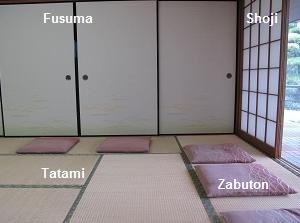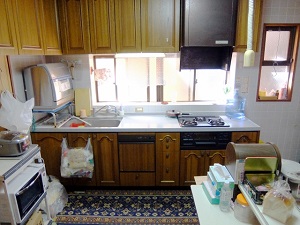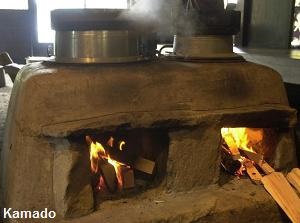Traditional Japanese house
The parts of Japanese traditional house
Roof

Old Japanese house with kawara roof
Traditional Japanese house is generally roofed with tiles.
The roof tile is called as "kawara" in Japanese, and the color is blackish.
But recently we can find blue or brown roof tiles on the new houses.
Therefore, in old town, we see the scenery of black roofs and dark wooden walls of the houses.
This is the typical scenery of Japan.
In the rural area, there have been the roofs made of straw or stem of reed.
It is difficult to find them today.
But you can find traditional houses with such roof at Shirakawa-go and Gokayama villages.
They have been designated as a World Heritage Site.
In Hokkaido, the roofs of most houses are made of galvanized iron.
Because, snow lies thick in winter and it is easy to slide snow down from roof.
Entrance

Entrance of Japanese house
The entrance of Japanese house is the place where you take off your shoes.
So there is a shoe cupboard aside.
And generally there is a step to the room, and it is 20 to 40 centimeters high.
In short, Japnese house is high-floored a little.
You must walk about the Japanese house without your shoes.
In some houses, slippers are prepared for walking on the board floor.
Fusuma and Shoji as room partition

Fusuma and Shoji in Japanese room
Roughly speaking, traditional Japanese room doesn't have concept of privacy.
Because one or two sides of the room are all keyless sliding doors.
In addition, the sliding door is screen of paper.
The sliding doors are called as "fusuma" or "shoji" in Japanese.
Fusuma is a door pasted with an opaque paper on a wooden frame.
Shoji is a door pasted with a white and thin paper on a wooden lattice frame.
Because thin papers of Shoji can get the outdoor light, Shoji is mainly set up for the doors and windows facing the garden.
When you open a fusuma or shoji, you can find the next room.
In Japanese house, fusuma and shoji have the function of both doors and walls.
They are like partitions in the house.
If some fusuma and shoji are removed, a wide room is completed easily.
When the owner invites many guests, the main room for the guests is set up by this way.
Fusuma was the canvas of artists in medieval times.
Many pictures by famous artists are remained in historic castles and residences.
Tatami floor

Surface of Tatami mat
Tatami mats are laid on the floor in Japanese room.
Probably, this is the place that you feel real Japan strongly.
Tatami is the floor mat which has developed in only Japan.
The surface of a tatami is covered by the mat woven of stems of soft rush grass, and straws of rice are stuffed inside.
It keeps the temperature in the room, and has hygroscopic property.
It fits the climate of Japan.
But it is a floor material, so it is not so soft.
A tatami is rectangular, and it is about 1.8 meters long by 0.9 meters wide.
The thickness is about 5 centimeters.

Tokonoma in a Japanese room
The size of the room is based on the number of tatamis.
The name of unit is "jo".
The variety of common room size is the following.
3-jo, 4.5-jo, 6-jo, 8-jo, 10-jo and 12-jo.
(In 4.5-jo room, four full-size tatamis and a half-sized tatami are used.)
When tatamis are laid in a room, there is a rule that the point by the corners of four tatamis like a cross must be avoided.
("Four" is read as "shi" in Japanese, and it is the same pronunciation of the word meaning "death".)
So, all corners of tatamis are set up like T-shape.
When you enter the room of tatamis, you must walk, sit or lie on the tatami without shoes.
Often, the guest room has a "Tokonoma".
Tokonoma is an alcove and a few art works or flowers are displayed for guest.
The tokonoma side in the room is the place of honor.
Kitchen and dining room

Common kitchen in Japan
Modern house in Japan is narrow, so kitchen in such house is also narrow.
There are a small sink and kitchen stove.
And a few cupboards and a refrigerator are usually placed nearby.
The cook can work by moving only a few steps.
In traditional house, there was a kitchen at north of house.
Because it is hot and humid in summer, it is a means to protect food against spoilage.

Until around the 1960s, Japanese people had used "kamado".
Kamado is the Japanese cooking hearth installed on dirt floor.
They set some pots or kettles on it and burn firewood under them.
Few house use kamado in Japan today, but we know that the boiled rice cooked with kamado is best.
So a few ryokans or minshukus use the traditional kamado and appeal to the travelers.
Originally, Japanese house don't have a dining room.
The family has meals at living room, and they serve guests a meal at guest room.
But recent houses have a dining room near a kitchen.

Some old houses in mountain village have "irori".
Irori resembles a fireplace without chimney.
A square hole is dug in the middle of a room, and fire is kindled with firewood as fuel.
In the center, a pot hanger is suspended from the ceiling, from which cookpots or iron kettles are hung.
Hot pot cooking and boiled water are made automatically on the irori.
The members of the family and the guests sit down around the irori.
And they have a meal and have a pleasant time warming themselves at the fire.
It is like a kitchen and a dining room.
Irori is already not being general, but you may be able to experience it in any old minshuku (small family-run inn) in the mountain village.
Garden

Engawa and narrow garden in an old house
Japan is a narrow country and many people are living there.
So, the site of the house is not generally wide.
Therefore, the garden of the most houses is very narrow.
Many houses in big cities have no garden.
Many of the luxury houses have a little wide garden, and Japanese-style scenery is set up.
It is the image of nature.
Several trees are planted, some rocks are put and there is a little pond.
It is not a geometric design.
The famous Japanese gardens are same as this concept.
Commonly, there is a "engawa" in front of the garden.
Engawa is like a balcony of wooden floor, and you can step out from a room.
This is the place that we can see the garden in a relaxed mood and take the air.
Most farm houses in the rural area have the garden.
But it is open space and is used as working space.
Farmers need the space to thresh rice, wheat and other grains or dry harvestry in the sunshine.
But the farmers recently is decreasing, so many farmers use the garden as their car parking space.
Toilet

Toilet seat with warm-water cleaning seat
In Japan, traditional toilet had the squat toilet without seat.
Now, it has been changed to western-style toilet in most places.
Additionally warm-water cleaning toilet seat is popular at many hotels and ryokans.
After relieving nature, when you press the button by the seat, warm and soft shower wash your buttocks.
It was developed by Japanese companies for the public around 1980, and became popular nationwide.
It is sold as one of electric goods, so it is installed at many ordinary houses in Japan.

Old squat toilet
However, you may find sometimes squat toilet in old ryokan or public toilet.
If you have no experience of squat toilet, please observe the following points and try once.
While you are squatting, you had better hold a handrail or touch your hand on the wall.
And get off all clothes of lower half of your body, and it gets easy to squat.
Bathroom
Most Japanese houses have a bathroom.
But, because the house is narrow, the bathroom is also narrow.
The bathtub is about the same size as the budget hotel.
But, because Japanese people like soaking in the bathtub, the bathtub is filled with hot water.
And the bathroom is used by the member of the family in turns.
How to spend in Japanese room
Ways of sitting

In Japanese room, you wear no shoe.
So you are free to stand, sit and lie there.
But when you have a meat or take part in a ceremony in the room, you must sit directly on the tatami floor.
Formal sitting is that you fold your legs so that the body rests on your heels.
It is called as "seiza" in Japanese.
If you are not accustomed to it, you feel painful when you do it for a long time. Probably you feel you have got pins and needles in your leg.
If the pain isn't supportable, you may do the relaxed way of sitting.
If you are a male, put your buttocks on the floor and put your legs out in front with the knees bent and cross a foot under the other leg.
This way is called "agura" in Japanese.
If you are a female, it is ill-mannered to do "agura".
Maintain the formal sitting with knees together, and move your buttocks off to the side of your feet.
(But if you are a male and do this pose, you look like gay...)
In each case, please say "Excuse me" as a manner.

Zabuton and Japanese table
Nevertheless, if you are painful, stretch out your legs as a last resort!
(I remember that President Reagan of the United States did so at a Japanese room in the mountain lodge held a summit meeting by Prime Minister Nakasone when he came to Japan in 1983.)
In guest room, "Zabuton" is commonly put at your sitting place.
Zabuton is a square Japanese cushion.
If you sit in a zabuton, it may ease your pain of sitting.
Bedding

Futons on tatami in Japanese room
In Japanese room, you sleep on a set of "futon".
There are two kinds of futon.
One is a mat to sleep on and another is a quilt to be covered with.
A futon is filled with cotton or feathers.
The set of futon is stored in a closet when it is not used.
And futon is laid out on the tatami floor directly, before going to bed.
In short, tatami mat has the function of both floor and bed.
Japan is quite humid, so futon is hung out on fine days to air in the sun.
In most ryokans a few attendants come to lay out the futon after dinner.
Futon are laid out directly on the tatami floor.
A pillow is put on the mat of futon.
Most of Japanese pillows are filled with buckwheat husks or small plastic pipes. So you may feel hard on back of head.
Kotatsu in winter

Kotatsu in winter
Basically, the inside of traditional Japanese house is cold in winter.
So, Kotatsu have been used on the tatami mats in the living room since ancient times.
Kotatsu is a Japanese table with a heater and a blanket is covered on the kotatsu.
If you put your legs into the warm inside, you will want not to leave that.
Even now, there are many families using Kotatsu across Japan.
And there are some ryokans and minshukus that Kotatsu is set up in the Japanese room.


